Tähtitieteellinen yhdistys Ursa
Ilmakehän optiset ilmiöt

Displays
16.4.
During this and the next day, Eastern Germany was overcast from low clouds which came from several troughs across Eastern Europe. Western Germany and the Netherlands had cirrus belonging to the warm front of a Nordic low pressure area. Above Finland, a cold front, an arm of the Eastern European troughs, first crossed over, followed by an occlusion of the Nordic low pressure system, which later developed a second cold front... Hence informs us Claudia from Chemnitz again. Between both of these fronts, Finland enjoyed longer lower-cloud breaks, which gave a free view to the higher clouds and their halos.
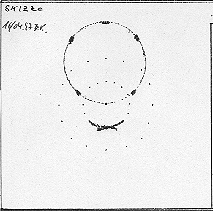
The day seems to have been better than the couple of previous ones. Displays of a little better level were seen in Oulu and Savukoski, but still nobody could see any rare halos. Everyone of the trio Aikioniemi-Korhonen-™hman reported the supralateral arc, and Aikioniemi also saw the parhelic circle. The circumzenithal arc is mentioned to have been the brightest one Aikioniemi has ever seen.
Gerrit Breman reported a short sun pillar "1-2 degrees above horizon under cloud-bank" in the northern part of the Netherlands. Halos belonging to the same class were seen again in Germany. A clear exception to the level of the displays for the day was made by Dieter Klatt in Oldenburg. Klatt has observed a well developed display with the parhelic circle and both 120° parhelia. In addition to these, the drawing contains anthelion and a short 22° halo with the 22° tangent arc.
Satellite image: Apr 16, 12:28 GMT
16./17.4.
Bretschneider, Rendtel and Löwenherz observed an almost entire 22° halo circling the Moon, the Sun's nocturnal sister, that does not allow peace of vigilance at night when ordinary countrymen tend to sleep without the bother of incredible bolides or celestial jewels of icy nature that might be missed. The night shift of meteorology experts at Laage-Kronskamp airport join in to take the lunar 22° halo in account...as well as Karl Kaiser noticing the small halo ring at his home quarters in the beautiful Schlägl village, Austria.
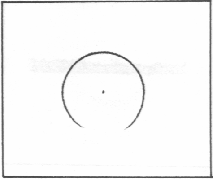
17.4.
Local halos were observed by Marian Beukers-Wilming and Gerrit Breman in the area of Assen - Veenhuizen. Marian admired a low solar elevation display with the v-shaped upper tangent arc and a long sun pillar. Gerrit saw also two halo forms, the upper tangent arc and the circumzenithal arc.
Some kind of high level clouds were drifting also above Germany, where a few observers saw some basic halos. Displays with the four most common halo forms - 22° halo, sun pillar, 22° tangent arc and parhelia - were seen in several combinations almost in every observing site of Finland. Nobody could see all of them, the luckiest observer being Olli Manner in Helsinki. First, at noon, he detected 22° halo and 22° tangent arc, and five hours later caught also another parhelion.
On 17th, as well as from 25th came also two reports of anthelia from one same observer. Given the very short information, the lack of photographs and the presence of only a 22° halo piece ten minutes later (in the other display) it is difficult to judge whether these would indeed have been genuine anthelia or other effects, such as cloud intensifications. A video material or extensive photographing over considerable time would be good to have regarding top abnormality containing reports. Anthelia without any other halos being present belongs definitely in this category.
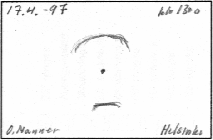
Satellite image: Apr 17, 12:17 GMT
17./18.4.
A lunar 22° halo was detected on three locations in the southern Finland. In Kuusankoski Marko Toivonen also saw a 22° tangent arc, but Mäkelä, Virjonen and Luukkonen were not allowed to see such well developed activity. Löwenherz appeared to be the most fortunate in Europe with an observation containing the 22° halo and the circumscribed halo.
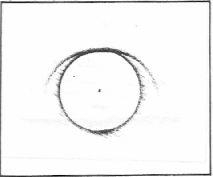
18.4.
About the 18th Claudia analyses to us that the "Finnish" cold front reached Central Europe and Great Britain, with some halos ahead of it. Finland was under the influence of a Russian warm front to the south, and a depression above the Arctic Ocean and the Barents Sea. There, more and larger halo displays were spotted in widespread cirrus-fields. Compared to this, places further south had widespread high clouds with halos, but they were also partly overcast with lower clouds.
Mika Sillanpää saw a big, coloured ellipse in the morning in Espoo. There was also a short sun pillar present. The halo was formed in virga of altocumulus. First the ellipse was white and visible as brightenings in the cloud filaments, but in the second part of the display the upper parts of the ellipse had turned brighter and had colours of red and green. Mika reports the vertical diameter of the halo was about ten degrees, so the halo was one of the biggest ellipses ever documented.
He remembered to check the polarization of the halo, and made an observation of clear vertical polarization, just like he had observed in September -96. A few polarization observations has been made since that, and all of them indicate that the light of the elliptical halos is unpolarized. Those observations are mainly made in the moonlight (but check the observation of Martti Penttinen on 4.4!), which perhaps could explain the disagreement. Also Veikko Mäkelä reported about similar potentially ellipse-originating clouds in the sky, but he was not fortunate to see more than a short pillar.
A little better-than-average display with regular ice crystals was recorded in Northern Finland. In addition to the usual 22° region halos, the 46° degree area was a bit active. The best observations were those made by Korhonen, Palojärvi and ™hman, who caught also the parhelic circle.
In the Netherlands, Breman observed 22° halo and circumzenithal arc. The display had about the same quality as the one in the most of locations of Finland. In Germany, the display seems to have had an intensity enough to be seen by 14 observers. The area of best available observations was again in the eastern parts of Germany, where Wächter and Lau observed the 46° halo as the most far-developed halo form of the day.
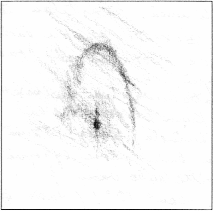
Satellite image: Apr 18, 12:05 GMT
19.4.
A British anticyclone spread out over Central Europe too, reducing halo numbers mostly to some lunar ones from the trailing-edge frontal cirrus. An inferior display performed in Eastern Germany. Five observers saw some modest halos.
In Finland a ridge of this high pressure area pushed between an Atlantic low and a Russian warm front; both of these were guilty of producing extensive fields of cirrus and therefore for giving good halo weather. The activity of 46° region was apparent. Piikki paid attention to the supralateral arc in Juva. An interesting observation was made by Toivonen in Kuusankoski: only the circumzenithal and the supralateral arcs. The absence of the common 22° halos is clearly caused by some low level clouds.
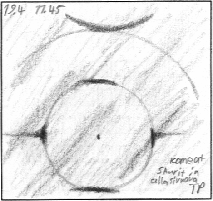
Satellite image: Apr 19, 11:55+13:35 GMT
19./20.4.
Marko Toivonen was the only one to witness this beautiful and abnormally sophisticated lunar halo. Indeed a combination quite seldom nocturnal halos were detected by Marko in the dark sky: the circumzenithal arc (exclamation mark) and the 46° supralateral arc.
Hinz, Hetze, Berthold and Lau capture a 22° halo in various places in Germany. Thomas Voigt takes variability victory over his countrymen by witnessing the 22° tangent arcs as well in Coswig, Germany.
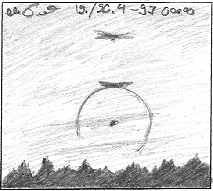
20.4.
High pressure with scarcely any clouds for Central Europe. More interest was found with the Finnish weather, where both fronts clashed and together killed-off the high pressure arm there. The result: thick clouds and rain or snow, with only some halos in snow or ice crystals. The few observations were mostly made in the Northern Finland. As an exception to this Ismo Luukkonen saw a sun pillar formed in Stratocumulus virga. The same halo formed in cirrostratus was seen in Savukoski by Helenius and Aikioniemi. In Finland the only coloured arc of the day was the 22° halo seen by Janne Soutukorva in Muonio.
The best single form was parhelion in Veenhuizen, where Gerrit Breman was again making observation of these phenomena. All of the forms mentioned above were seen in Germany as well, one of the observers being the in length halo observed Günter Röttler of whose drawing production is attached here.
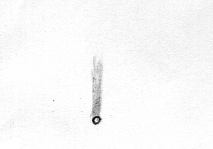
Satellite image: Apr 20, 11:44+13:24 GMT
20./21.4.
Karl Kaiser takes notice of a well-developed 22° halo in Schlägl, Austria. Rest of the Europe sleeps, is clouded over or just stays without lunar halos.
<link harrastus jaostot ilmakehan-optiset-ilmiot havaitseminen havaintoja european-halo-project.html _blank>European Halo Project | <link harrastus jaostot ilmakehan-optiset-ilmiot havaitseminen havaintoja european-halo-project ehp-1997.html _blank>Contents | <link harrastus jaostot ilmakehan-optiset-ilmiot havaitseminen havaintoja european-halo-project ehp-1997 display-descriptions apr-11-15.html _blank>Previous chapter | <link harrastus jaostot ilmakehan-optiset-ilmiot havaitseminen havaintoja european-halo-project ehp-1997 display-descriptions apr-21-25.html _blank>Next chapter
-
 Useita halomuotoja II 2.1.2026 klo 20.34; Nivala; Heli Ojalehto
Useita halomuotoja II 2.1.2026 klo 20.34; Nivala; Heli Ojalehto -
 Harvinaisia halomuotoja IV 2.1.2026 klo 19.00; Oulu; Marja Marttila
Harvinaisia halomuotoja IV 2.1.2026 klo 19.00; Oulu; Marja Marttila -
 Useita halomuotoja II 2.1.2026 klo 19.00; Raahe; Irina Jylhä
Useita halomuotoja II 2.1.2026 klo 19.00; Raahe; Irina Jylhä -
 Yksi halomuoto I 2.1.2026 klo 18.00-18.01; Haapavesi; Osmo Hyvärinen
Yksi halomuoto I 2.1.2026 klo 18.00-18.01; Haapavesi; Osmo Hyvärinen -
 Useita halomuotoja II 2.1.2026 klo 13.00-13.10; Kajaani; Mervi Juntunen
Useita halomuotoja II 2.1.2026 klo 13.00-13.10; Kajaani; Mervi Juntunen -
 Useita halomuotoja II 2.1.2026 klo 12.30-14.00; Raahe; Mikko Silvola
Useita halomuotoja II 2.1.2026 klo 12.30-14.00; Raahe; Mikko Silvola -
 Useita halomuotoja II 2.1.2026 klo 11.00-14.00; Raahe; Irina Jylhä
Useita halomuotoja II 2.1.2026 klo 11.00-14.00; Raahe; Irina Jylhä -
 Keinovalopilareita II 2.1.2026 klo 2.00-3.00; Kempele; Marko Haapala
Keinovalopilareita II 2.1.2026 klo 2.00-3.00; Kempele; Marko Haapala
-
 Yksi halomuoto I 2.1.2026 klo 0.27; Parkano; Soili Jalava
Yksi halomuoto I 2.1.2026 klo 0.27; Parkano; Soili Jalava -
 Harvinaisia halomuotoja IV 2.1.2026 klo 0.25-4.10; Vaasa; Timo Alanko
Harvinaisia halomuotoja IV 2.1.2026 klo 0.25-4.10; Vaasa; Timo Alanko -
 Yksi halomuoto I 2.1.2026 klo 0.05-0.15; Kauhajoki; Anu Kilpiö
Yksi halomuoto I 2.1.2026 klo 0.05-0.15; Kauhajoki; Anu Kilpiö -
 Useita halomuotoja II 1.1.2026 klo 22.50-23.30; Seinäjoki; Pekka Lähteenmäki
Useita halomuotoja II 1.1.2026 klo 22.50-23.30; Seinäjoki; Pekka Lähteenmäki -
 Keinovalopilareita 1.1.2026 klo 22.00-22.30; Oulu; Ari Juntunen
Keinovalopilareita 1.1.2026 klo 22.00-22.30; Oulu; Ari Juntunen
-
 Useita halomuotoja II 1.1.2026 klo 22.00 - 2.1.2026 klo 7.00; Vaasa; Juha Varis
Useita halomuotoja II 1.1.2026 klo 22.00 - 2.1.2026 klo 7.00; Vaasa; Juha Varis -
 Yksi halomuoto I 1.1.2026 klo 21.47; Simo; Joni Alavesa
Yksi halomuoto I 1.1.2026 klo 21.47; Simo; Joni Alavesa
![[EHP]](fileadmin/_migrated/RTE/RTEmagicC_664970cc8d.gif.gif)
